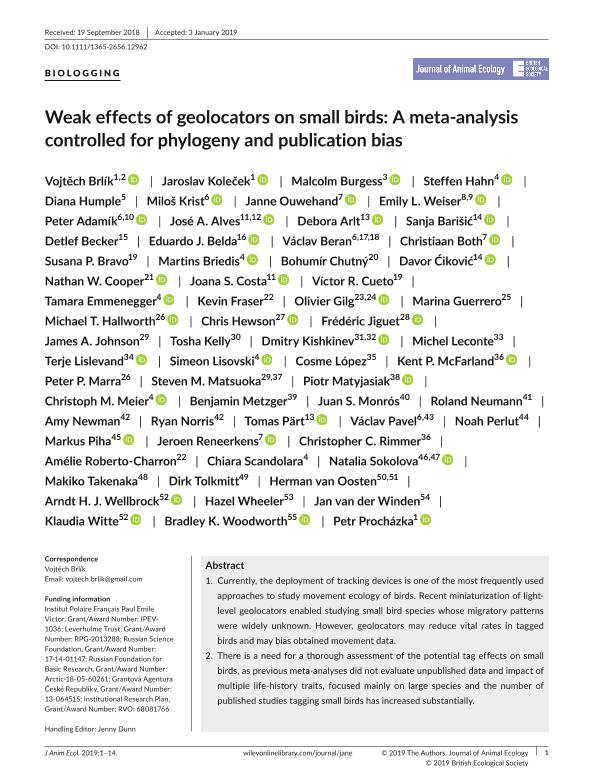Artículo
Weak effects of geolocators on small birds: A meta-analysis controlled for phylogeny and publication bias
Vrojtech, Brlik; Kolecek, Jaroslav; Burgess, Malcolm; Hahn, Steffen; Humple, Diana; Krist, Milos; Ouwehand, Janne; Weiser, Emily; Adamík, Peter; Alves, José; Arlt, Debora; Barisic, Sanja; Becker, Detlef; Belda, Eduardo; Beran, Václav; Both, Christiaan; Bravo, Susana Patricia ; Briedis, Martins; Chutny, Bohumir; Cikovic, Davor; Cooper, Nathan; Costa, Joana; Cueto, Víctor
; Briedis, Martins; Chutny, Bohumir; Cikovic, Davor; Cooper, Nathan; Costa, Joana; Cueto, Víctor ; Emmenegger, Tamara; Fraser, Kevin; Gilg, Olivier; Guerrero, Marina; Hallworth, Michael; Hewson, Chris; Jiguet, Frédéric; Johnson, James; Kelly, Tosha; Kishkinev, Dmitry; Leconte, Michel; Lislevand, Terje; Lisovski, Simeon; López, Cosme; McFarland, Kent; Marra, Peter; Matsuoka, Steven; Matyjasiak, Piotr; Meier, Christoph; Metzger, Benjamin; Monrós, Juan; Neumann, Roland; Newman, Amy; Norris, Ryan; Pärt, Tomas; Pavel, Václav; Perlut, Noah; Piha, Markus; Reneerkens, Jeroen; Rimmer, Christopher; Roberto Charron, Amélie; Scandolara, Chiara; Sokolova, Natalia; Takenaka, Makiko; Tolkmitt, Dirk; van Oosten, Herman; Wellbrock, Arndt; Wheeler, Hazel; van der Winden, Jan; Witte, Klaudia; Woodworth, Bradley; Prochazka, Petr
; Emmenegger, Tamara; Fraser, Kevin; Gilg, Olivier; Guerrero, Marina; Hallworth, Michael; Hewson, Chris; Jiguet, Frédéric; Johnson, James; Kelly, Tosha; Kishkinev, Dmitry; Leconte, Michel; Lislevand, Terje; Lisovski, Simeon; López, Cosme; McFarland, Kent; Marra, Peter; Matsuoka, Steven; Matyjasiak, Piotr; Meier, Christoph; Metzger, Benjamin; Monrós, Juan; Neumann, Roland; Newman, Amy; Norris, Ryan; Pärt, Tomas; Pavel, Václav; Perlut, Noah; Piha, Markus; Reneerkens, Jeroen; Rimmer, Christopher; Roberto Charron, Amélie; Scandolara, Chiara; Sokolova, Natalia; Takenaka, Makiko; Tolkmitt, Dirk; van Oosten, Herman; Wellbrock, Arndt; Wheeler, Hazel; van der Winden, Jan; Witte, Klaudia; Woodworth, Bradley; Prochazka, Petr
 ; Briedis, Martins; Chutny, Bohumir; Cikovic, Davor; Cooper, Nathan; Costa, Joana; Cueto, Víctor
; Briedis, Martins; Chutny, Bohumir; Cikovic, Davor; Cooper, Nathan; Costa, Joana; Cueto, Víctor ; Emmenegger, Tamara; Fraser, Kevin; Gilg, Olivier; Guerrero, Marina; Hallworth, Michael; Hewson, Chris; Jiguet, Frédéric; Johnson, James; Kelly, Tosha; Kishkinev, Dmitry; Leconte, Michel; Lislevand, Terje; Lisovski, Simeon; López, Cosme; McFarland, Kent; Marra, Peter; Matsuoka, Steven; Matyjasiak, Piotr; Meier, Christoph; Metzger, Benjamin; Monrós, Juan; Neumann, Roland; Newman, Amy; Norris, Ryan; Pärt, Tomas; Pavel, Václav; Perlut, Noah; Piha, Markus; Reneerkens, Jeroen; Rimmer, Christopher; Roberto Charron, Amélie; Scandolara, Chiara; Sokolova, Natalia; Takenaka, Makiko; Tolkmitt, Dirk; van Oosten, Herman; Wellbrock, Arndt; Wheeler, Hazel; van der Winden, Jan; Witte, Klaudia; Woodworth, Bradley; Prochazka, Petr
; Emmenegger, Tamara; Fraser, Kevin; Gilg, Olivier; Guerrero, Marina; Hallworth, Michael; Hewson, Chris; Jiguet, Frédéric; Johnson, James; Kelly, Tosha; Kishkinev, Dmitry; Leconte, Michel; Lislevand, Terje; Lisovski, Simeon; López, Cosme; McFarland, Kent; Marra, Peter; Matsuoka, Steven; Matyjasiak, Piotr; Meier, Christoph; Metzger, Benjamin; Monrós, Juan; Neumann, Roland; Newman, Amy; Norris, Ryan; Pärt, Tomas; Pavel, Václav; Perlut, Noah; Piha, Markus; Reneerkens, Jeroen; Rimmer, Christopher; Roberto Charron, Amélie; Scandolara, Chiara; Sokolova, Natalia; Takenaka, Makiko; Tolkmitt, Dirk; van Oosten, Herman; Wellbrock, Arndt; Wheeler, Hazel; van der Winden, Jan; Witte, Klaudia; Woodworth, Bradley; Prochazka, Petr
Fecha de publicación:
02/2019
Editorial:
British Ecological Society
Revista:
Journal of Animal Ecology
ISSN:
0021-8790
Idioma:
Inglés
Tipo de recurso:
Artículo publicado
Clasificación temática:
Resumen
Currently, the deployment of tracking devices is one of the most frequently used approaches to study movement ecology of birds. Recent miniaturization of light-level geolocators enabled studying small bird species whose migratory patterns were widely unknown. However, geolocators may reduce vital rates in tagged birds and may bias obtained movement data. There is a need for a thorough assessment of the potential tag effects on small birds, as previous meta-analyses did not evaluate unpublished data and impact of multiple life-history traits, focused mainly on large species and the number of published studies tagging small birds has increased substantially. We quantitatively reviewed 549 records extracted from 74 published and 48 unpublished studies on over 7,800 tagged and 17,800 control individuals to examine the effects of geolocator tagging on small bird species (body mass <100 g). We calculated the effect of tagging on apparent survival, condition, phenology and breeding performance and identified the most important predictors of the magnitude of effect sizes. Even though the effects were not statistically significant in phylogenetically controlled models, we found a weak negative impact of geolocators on apparent survival. The negative effect on apparent survival was stronger with increasing relative load of the device and with geolocators attached using elastic harnesses. Moreover, tagging effects were stronger in smaller species. In conclusion, we found a weak effect on apparent survival of tagged birds and managed to pinpoint key aspects and drivers of tagging effects. We provide recommendations for establishing matched control group for proper effect size assessment in future studies and outline various aspects of tagging that need further investigation. Finally, our results encourage further use of geolocators on small bird species but the ethical aspects and scientific benefits should always be considered.
Archivos asociados
Licencia
Identificadores
Colecciones
Articulos(CIEMEP)
Articulos de CENTRO DE INVESTIGACION ESQUEL DE MONTAÑA Y ESTEPA PATAGONICA
Articulos de CENTRO DE INVESTIGACION ESQUEL DE MONTAÑA Y ESTEPA PATAGONICA
Citación
Vrojtech, Brlik; Kolecek, Jaroslav; Burgess, Malcolm; Hahn, Steffen; Humple, Diana; et al.; Weak effects of geolocators on small birds: A meta-analysis controlled for phylogeny and publication bias; British Ecological Society; Journal of Animal Ecology; 89; 1; 2-2019; 207-220
Compartir
Altmétricas



